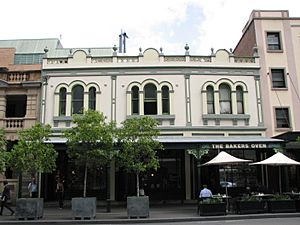123-125 George Street, The Rocks facts for kids
Quick facts for kids 123-125 George Street, The Rocks |
|
|---|---|

123-125 George Street, The Rocks
|
|
| Location | 123-125 George Street, The Rocks, City of Sydney, New South Wales, Australia |
| Built | 1882 |
| Built for | Thomas Playfair |
| Architectural style(s) | Victorian Free Classical |
| Owner | Property NSW |
| Official name: Shop and Residence | |
| Type | State heritage (built) |
| Designated | 10 May 2002 |
| Reference no. | 1583 |
| Type | Shop |
| Category | Retail and Wholesale |
| Lua error in Module:Location_map at line 420: attempt to index field 'wikibase' (a nil value). | |
123-125 George Street, The Rocks, is a special old building in The Rocks, a historic part of Sydney, Australia. It used to be shops and homes. This building was built in 1882 for a man named Thomas Playfair.
Today, it is owned by Property NSW, which is part of the Government of New South Wales. The building is considered very important because of its history and design. It was added to the New South Wales State Heritage Register on 10 May 2002. This means it's officially protected so people can enjoy it for many years.
Contents
Building History
This area was first given to William Davis in 1836. He built some houses there. Around 1830, Davis built a small shop on George Street. It had brick walls and a shingle roof. In 1842, he added another similar shop next to it.
By 1845, these two shops were described as being "in bad repair." One shop was about 4 meters wide, and the other was about 4.3 meters wide. In 1863, the houses behind the shops were called "old and ruined."
In 1870, one shop was a greengrocer, and the other was a bootmaker. They stayed like this until 1881. That's when the old shops and houses were pulled down.
New Shops Built
A man named Thomas Playfair bought the land in 1882. He built two new two-story shops there. These new shops had four rooms each. They were made of brick and stone, with iron roofs.
The greengrocer, J. Paddon, moved into the new shop at No. 123. A bootmaker, C. W. Danielson, moved into No. 125. Later, No. 125 became a clothing store. Thomas Playfair owned these shops until 1900. Then, the NSW Government took over the property.
What the Building Looks Like
The buildings at 123 and 125 George Street were built around 1880. They are two stories tall. They are made of brick covered in stucco, which is a type of plaster.
The first floor has unique windows. They are in a style called Romanesque. Two of the shops still have their original shopfronts. The third shop has been changed.
Nos. 123 and 125 George Street look almost the same. The wooden shopfront at 123 is new, but it's a copy of the original one at 125. Inside, 123 and 125 are connected and used as one big shop. Most of the ceilings are new, but the original wooden parts are still there. The decorative metal wall at the top is a copy of the old one.
Building Style and Materials
The building's style is called Victorian Free Classical. It has two stories. The outside walls are made of brick and stone. The roof is made of corrugated iron. The floors inside are made of timber.
Why This Place is Special
This pair of shops and homes is very important to the history of New South Wales. The building and its location are also special because they are part of The Rocks area. The Rocks itself is a very important historical place.
Connection to Important People
The buildings at 123-125 George Street are connected to Thomas Playfair. He was the Mayor of Sydney in 1885. Playfair was involved in the shipping business. He also bought properties in the area, like this one.
Beautiful Design and Appearance
The front of these buildings shows a great example of the Victorian Free Classical style. This style made simple shops and homes look fancy. The buildings look like one big property, even though they are two separate ones. They fit in well with the other old buildings on George Street in The Rocks. The front of the buildings has stayed mostly the same since 1882.
Long History of Use
These buildings have been used as shops since they were built in 1882. They have been many different kinds of businesses. They were fruit shops, meat shops, wine stores, and clothing stores. In 1933, one shop was even used by a company that got rid of pests!
The buildings show how shops and homes used to be combined. This was very common in The Rocks and all over Sydney a long time ago.
Learning from the Past
Even though the building has been changed a bit, it can still teach us things. It shows us how commercial and residential buildings were designed in the late Victorian era. It also gives us clues about how people lived back then.
The land under the building might also hold secrets. It has the potential to show us more about how Europeans first settled in this area.
Showing Key Features of the Area
The buildings at 123 and 125 George Street show how closely connected homes and businesses were in The Rocks in the 1800s. They help us understand the community's daily life back then.

